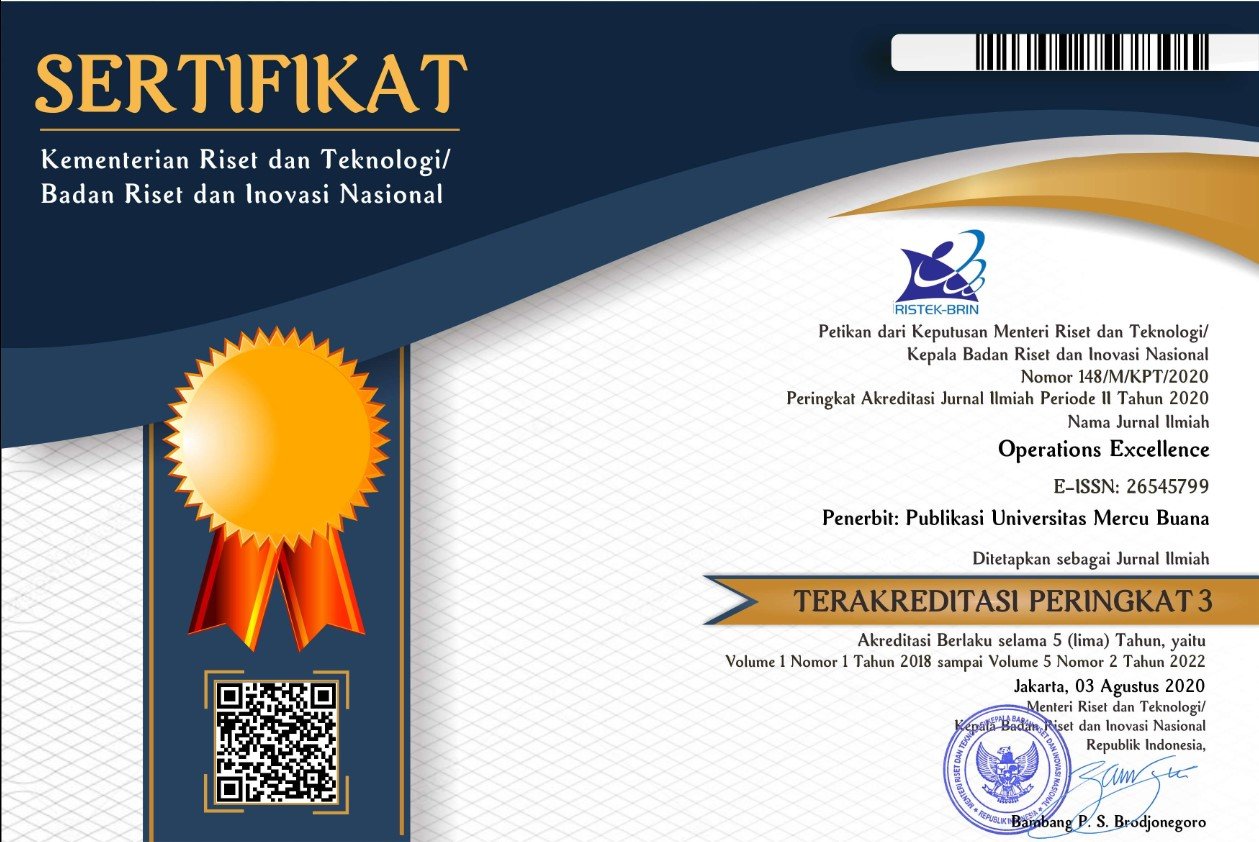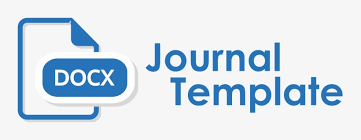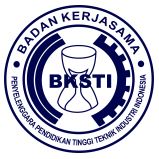Analisis Manajemen Risiko Rantai Pasok Pada Produk Alat Berat Penunjang Industri Pertambangan
Abstract
Manufacturing activities such as trailer products potentially generate various risks. This research aims to analyze risk management in the supply chain of trailer production using the House of Risk (HOR) model. The business activities mapping is using the Supply Chain Operations Reference (SCOR) method which consists of 6 parts of the management process, plan, source, make, deliver return and enable. Research is conducted through two phases of HOR. The HOR 1 activities are the identification of risk events and risk agents based on SCOR mapping, measurement of severity, and occurrence levels to produce an Aggregate Risk Priority (ARP), then determine a priority risk agent in the mitigation process. The HOR 2 is used to determine which actions are to be done first, considering their differing effectiveness as well as resources involved and the degree of difficulties in performing. The company should ideally select a set of actions that are not so difficult to perform but could effectively reduce the probability of risk agents occurring. 7 experience respondents were involved in the study consisting of engineering, procurement, production, warehouse, production planning, after-sales dan quality control. The results of the analysis successfully identified 46 risk events and 41 risk agents in the manufacturing of mining trailers. FGD and Pareto analysis used in the study produced 16 recommendations for mitigation actions that are expected to be able to mitigate risk.
Keywords
Full Text:
PDFReferences
Anjalee, J. A. L., Rutter, V., & Samaranayake, N. R. (2020). Application of Failure Mode and Effect Analysis (FMEA) to improve medication safety : a systematic review. 1–7. https://doi.org/10.1136/postgradmedj-2019-137484
Anwar, A. (2018). Pengukuran Kinerja Supply Chain Management Perguruan Tinggi Mengunakan Metode AHP-SCOR. Operations Excellence: Journal of Applied Industrial Engineering, 10(3), 263. https://doi.org/10.22441/oe.v10.3.2018.006
Aprianto, T., Setiawan, I., & Purba, H. H. (2021). Implementasi metode Failure Mode and Effect Analysis pada Industri di Asia – Kajian Literatur. Jurnal Manajemen & Teknik Industri – Produksi, 21(2), 165–174. https://doi.org/10.350587/Matrik
Aryanto, D., & Hasibuan, S. (2021). Framework pengukuran kinerja rantai pasok pada industri kemasan plastik menggunakan metode SCOR dan AHP. Operations Excellence: Journal of Applied Industrial Engineering, 13(2), 183–193. https://doi.org/10.22441/oe.2021.v13.i2.017
BPS. (2017). Produksi Barang Tambang Mineral Periode tahun 1996-2018. https://www.bps.go.id/dynamictable/2016/01/28/1126/produksi-barang-tambang-mineral-1996-2017.html (Accessed; 12122021)
Handoko, B., & Swara, A. W. (2020). Supply chain management performance measurement in the development of Indonesian new capital city using SCOR method. Operations Excellence: Journal of Applied Industrial Engineering, 12(1), 63. https://doi.org/10.22441/oe.2020.v12.i1.006
Hasibuan, S., Thaheer, H., Supono, J., & Irhamni. (2021). Analisis Risiko Pada Rantai Pasok Industri Minuman Siap Saji Jus Buah Dengan Pendekatan SCOR-FMEA. Operation Excellence Journal of Applied Industrial Engineering, 13(1), 73–85. https://doi.org/10.22441/oe.2021.v13.i1.010
Hosianna, G. R., Hasibuan, S., & Hidayati, J. (2021). Analisa risiko rantai pasok produk kosmetik sistem make to order dengan metode House of Risk. Operations Excellence: Journal of Applied Industrial Engineering, 2021(3), 288–297. https://doi.org/10.22441/oe.2021.v13.i3.027
Muhammad, J., Rahmanasari, D., Vicky, J., Maulidiyah, W. A., Sutopo, W., & Yuniaristanto, Y. (2020). Pemilihan Supplier Biji Plastik dengan Metode Analitycal Hierarchy Process (AHP) dan Technique for Order Preference by Similarity to Ideal Solution (TOPSIS). Jurnal INTECH, 6(2), 99–106. https://doi.org/10.30656/intech.v6i2.2418
Prasmoro, A. ., & Hasibuan, S. (2018). Optimasi Kemampuan Produksi Alat Berat Dalam Rangka Produktifitas Dan Keberlanjutan Bisnis Pertambangan Batubara: Studi Kasus Area Pertambangan Kalimantan Timur. Operations Excellence: Journal of Applied Industrial Engineering, 10(1), 1–16.
Rini, A. S. (2018). Permintaan Alat Berat Diyakini Terus Naik. https://ekonomi.bisnis.com/read/20180705/257/813550/permintaan-alat-berat-diyakini-terus-naik (Accessed; 12122021)
Stamatis, D. H. (1995). Failure Mode and Effect Analysis FMEA from Theory to Execution. ASQC Quality Press. New Jersey
Sugiyono. (2017). Metode Penelitian Kuantitatif, Kualitatif, dan R&D (1st ed.). CV Alfabeta. Yogyakarta
Tang, L. L., Chen, S. H., & Lin, C. C. (2020). Integrating fmea and the Kano model to improve the service quality of logistics centers. Processes, 9(1), 1–16. https://doi.org/10.3390/pr9010051
Ulfah, M. (2021). Mitigasi risiko rantai pasok industri furniture dengan menggunakan metode house of risk di IKM Sinar Muda. Journal Industrial Servicess, 7(1), 93. https://doi.org/10.36055/jiss.v7i1.12745
Wahid, M., & Hasibuan, S. (2021). Performance evaluation of after-sales service partners in the power tools industry. Jurnal Sistem dan Manajemen Industri, 5(2), 105–114. https://doi.org/10.30656/jsmi.v5i2.3985
DOI: http://dx.doi.org/10.22441/oe.2022.v14.i1.046
Refbacks
- There are currently no refbacks.
Copyright (c) 2022 Operations Excellence: Journal of Applied Industrial Engineering

This work is licensed under a Creative Commons Attribution-ShareAlike 4.0 International License.
Journal ISSN:
| Print ISSN: 2085-4293 | |
| Online ISSN: 2654-5799 |
Tim Editorial Office
Operations Excellence: Journal of Applied Industrial Engineering
Magister Teknik Industri Universitas Mercu Buana
Jl. Raya Meruya Selatan No. 1 Kembangan Jakarta Barat
Email: [[email protected]]
Website: http://publikasi.mercubuana.ac.id/index.php/oe
Journal DOI: 10.22441/oe
The Journal is Indexed and Journal List Title by:

.png)
.png)
.png)


Operations Excellence: Journal of Applied Industrial Engineering is licensed under a Creative Commons Attribution-NonCommercial-ShareAlike 4.0 International License.










